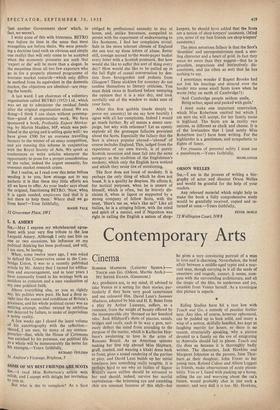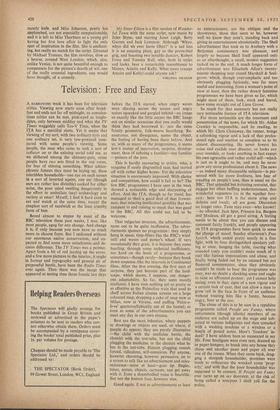Contemporary Arts
Cinema
SUMMER MADNESS. (Leicester Square.)— TOUCH AND Go. (Odeon, Marble Arch.)—. MY SISTER EILEEN. (Gaumont.) ALL producers are, to my mind, ill advised to take Venice as a setting for their stories, par- ticularly if they have very good cameramen and use coloured film. David Lean's Summer Madness, adapted by him and H. E. Bates from a play by Arthur Laurents, suffers, as a romance, from the weight of beauty offered by the incomparable city 'throned on her hundred isles. Jack Hildyard's shots of piazzas, canals, bridges and roofs, each in its way a gem, seri- ously deflect the mind from attending to the purpose of the matter, which is Katherine Hep- burn's awakening to love in the arms of Rossano Brazzi. As an American spinster making her first trip abroad Miss Hepburn, gruff, tousled, and wearing a khaki dress back to front, gives a sound rendering of the puritan at play, and David Lean builds up her initial loneliness into something really tangible. It is perhaps hard to see why an Italian of Signor Brazzi's suave calibre should be attracted to her and should, indeed, survive her tearful capitulation—the brimming eye and trembling chin are constant features of this idyll—but
he gives a very convincing portrait of a man in love and is charming. Nevertheless, the brief affair between a middle-aged typist and a mar- ried man, though carrying in it all the seeds of sweetness and tragedy, cannot, it seems, com- pete with the surrounding architecture, and all the magic of the film, its tenderness and joy, emanate from Venice herself. As a travelogue this picture is superb.
Ealing Studios have hit a rare low with Touch and Go, a comedy of peculiar feeble- ness. Any idea, of course, however ephemeral, can be padded up to look solid, and many a wisp of a notion, skilfully handled, has kept us laughing merrily for hours; so there is no reason, structurally speaking, why a picture devoted to a family on the eve of emigrating to Australia should fail to please. Touch and Go does so because it is thoroughly badly written. The characters, Jack Hawkins and Margaret Johnston as the parents, June Thor- burn as their daughter, John Fraser as her young man, Roland Culver and Alison Leggatt as friends, make observations of acute plausi- bility. You or I, faced with packing up a home, selling the car and worrying about the cat's future, would probably chat in just such a manner, and very dull it is too. Mr. Hawkins,
mostly irate, and Miss Johnston, pretty but unplumbed, are not especially companionable, and it is left to Miss Thorburn as a young girl having her first love affair to light the only spot of inspiration in the film. She is enchant- ing, but really no match for the script. Directed by Michael Truman, the film revolves, slow as a hearse, around West London, which, alas, unlike Venice, is not quite beautiful enough to compensate for the picture's dearth of wit, one of the really essential ingredients, one would have thought, of a comedy.
My Sister Eileen is a film version of Wonder- ful Town with the same script, new music by Jules Styne, and starring Janet Leigh, Betty Garrett and Jack Lemmon. Although 'Whyo. whyo did vle ever leave Ohio?' is a sad loss it is an amusing piece, gay as the proverbial grig, and boasting two'notable dancers, Robert Fosse and Tommy Rall, who, both in styles and looks, bear a remarkable resemblance to Messrs. Astaire and Kelly. What more (except Astaire and Kelly) could anyone ask?
VIRGINIA GRAHAM



































 Previous page
Previous page